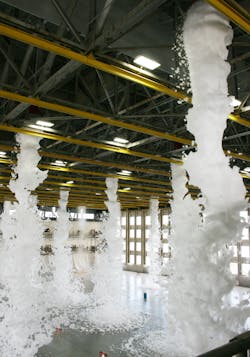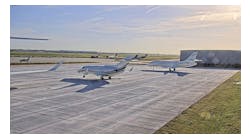Protecting Aircraft in Hangars: Six Keys to Successful Fire Detection and Mitigation
High-performance systems that detect fires and actuate supplemental suppression systems safeguard costly aircraft assets, as well as hangar structures and human life.
Aircraft hangar fire detection and protection systems are critical to protect the contents of the hangar and the facility itself. While a regional fixed base operator hangar might price out at $150,000 and a commercial jet airliner hangar at a few million, the commercial or military aircraft inside hangars can easily cost hundreds of millions of dollars.
When it comes to aircraft hangar fire detection, there are a number of standards, certification and regulatory agencies to satisfy. Fire protection codes like NFPA 409, military standards, insurance companies and authorities having jurisdiction (AHJs) may require or strongly recommend a high-performance fire detection and suppression system to protect aircraft assets, the hangar structure and human life.
Protecting valuable aircraft assets requires addressing a hangar’s unique site challenges:
- Large detection expanse and obstacles. Hangars are spacious buildings and aircraft bodies and wings stretch out to create sizable obstructions.
- Large hangar doors. Tall doors create variable conditions. When they’re open, a detector’s field of view (FOV) may include the runway and detect non-threatening flames that can potentially trigger false alarms—from sources like the afterburners of jets or auxiliary power units (APUs) in parked aircraft.
- Radio frequency interference (RFI). Hangars are also subject to RFI from avionics, ground-seeking airport radar and various communication devices, all of which can cause false fire alarm conditions to occur.
Hangars vary in size, type and number of aircraft they hold, and how they are equipped. Each hangar can be classified as belonging to one of four hangar group types, in compliance with NFPA 409 and the International Building Code, depending on construction, door height, building dimensions and the types of hazardous materials stored. When it comes to fire detection and mitigation systems, one size does not fit all. Each system must take a facility’s unique characteristics and requirements into account.
Following are six considerations essential to the planning, design and implementation of any aircraft hangar fire protection system:
Detecting flame in addition to heat and smoke
With aircraft getting larger, hangars are also getting larger. Historically, heat and smoke detectors have played the pivotal role in fire detection systems in hangars. The challenge is that in open or drafty areas, smoke and heat from a fire can dissipate, which can significantly delay detection or evade it altogether.
Traditional smoke and heat detection systems are intended to provide protection for the hangar structure. Optical flame detectors provide an earlier notification of the presence of fire, which in turn provides better protection of the costly assets inside. High-performance optical flame detectors with a wide FOV and long detection range can sense a 2 ft. x 2 ft. fire from up to 235 feet (71.638 meters) away, which enables detection and notification much more quickly than traditional protection schemes.
The NFPA 409 Standard on Aircraft Hangars refers to NFPA 72 for detector installation guidance, and NFPA 72 states that the spectral response of the detector to be installed must be matched to the spectral emission of the fire. It also states that an engineering evaluation shall determine the location and spacing of the detectors. This evaluation is based upon the fuel involved, size of the fire, and performance attributes of the flame detector. Using optical flame detectors that are third-party approved for the detection of jet fuel fires helps to satisfy this requirement.
U.S. military branches have recently specified optical flame detectors as part of the fire protection systems for new military hangar construction. There are also ongoing discussions about updating the Engineering Technical Letter (ETL) 02-15 Fire Protection Engineering Criteria – New Aircraft Facilities to include optical flame detectors or even triple infrared detectors.
Speeding detection and decision making
Automatic activation once heat or flame thresholds have been reached is a very effective way to speed detection and decision making. An aircraft fuselage skin can be damaged in as little as 45 seconds after initial contact with fire, so automatic activation can be critical for protection.
The time that it takes an activated suppression system to extinguish a fire depends on a number of factors and is quite variable, ranging from a few seconds to minutes. What does this mean for the accurate detection and activation sequence, and how quickly does it have to be carried out? The best answer is as quickly as possible, and obviously the less time spent here means more time available for suppression. A system that can receive and analyze data from multiple detectors, make error-free decisions and dispatch activation and alarm messages— in no more than 12 seconds—leaves over 30 seconds for the system to deluge the flame.
Locating flame detectors—and the role of 3D mapping
Expansive areas like hangars require comprehensive fire coverage, so a flame detector’s range and FOV are critical. Generally speaking, the greater the detector range and FOV, the fewer devices you will need to achieve full coverage. However, there may be situations where the detector’s area of coverage needs to be controlled to prevent it from picking up signals outside of hangar doors, such as those from the after-burners of jets or APUs in parked aircraft.
Adjustable swiveling mounting brackets, laser aiming devices and FOV limiters add precision to the aiming process and can be used to ensure that the top portion of the FOV ends at the hangar apron and does not extend out onto the tarmac, airfield, or runway.
Optical flame detectors must be positioned so they have a view beneath the aircraft’s wings and fuselage. Therefore, detector mounting heights are often dictated by the smallest aircraft stored in the hangar. It is equally important, however, to consider possible movable obstructions such as toolboxes and ladders. For this reason, wall-mounting of flame detectors at an optimal height is preferred over ceiling mounting. Areas where flammable solvents are used and stored are also typically monitored by gas, flame and smoke detectors.
To ensure compliance with NFPA 409, it is critical to use a performance-based design that adheres to the standards. This includes determining the specific mounting locations for optical flame detectors and typically requires a detailed analysis.
Ideally, large hangar installations will involve 3D flame mapping to determine nominal placement and aiming so that detector coverage is maximized and blind spots are eliminated. In addition to providing a highly illustrative three-dimensional diagram of the installation, a detailed software-driven approach generates in depth-quantitative statistical analyses that help raise the safety level of the site. 3D mapping can also provide reports and data essential for ongoing maintenance and for satisfying regulatory agencies, insurance claims and audits.
Rejecting false alarms
Hangars typically include sources of friendly fire that must be filtered out. For example, in cold climates, gas fired heaters are often used to heat hangars. When these heaters start up, a flame may momentarily exist within the heater which could possibly be within the FOV of a detector. An APU is another example of a potential friendly fire that could occur. These typically come from aircraft parked just outside of the hangar doors, but still within the detector’s FOV. These ‘real fires’ can become a source of alarm. As such, flame detection systems must be equipped with processing algorithms to ignore short-duration flames, while still providing optimal detection capability to liquid pool fire type hazards.
In order to reduce the probability of false alarms and unintended activations, it is imperative to use detectors that are highly resistant to false alarm sources, and also proven to be unaffected by electromagnetic interference/ radio frequency interference (EMI/RFI) energy.
False alarms can result in the unwarranted deployment of a fire suppression material. Foam deluge systems are designed to coat the hangar floor and large aircraft very quickly. Under normal conditions, sensing an actual fire and extinguishing it is a very good thing. However, if a deluge is triggered by a false signal, it comes at a price. Significant costs are incurred to clean up and remove discharged foam, recharge the suppression system and, in some cases, repair damages to the aircraft.
Building in redundancy
Using multiple detectors to monitor the same area in order to validate the detection of heat or flame, is a proven way to build in fire detection system redundancy. Redundant coverage of a hangar floor provides a more reliable means of ensuring a fire is detected, particularly in the face of commonplace detection obstacles such as maintenance activities. The presence of tool cribs, fork lifts and temporary storage can create temporary obstructions in an area monitored by a single flame detector. By utilizing additional detection, this issue can be overcome.
It is often typical to activate notification appliances and notify authorities upon the first detector detecting a fire, and if a second detector detects the same fire, the automatic activation of the suppression system is commenced. This methodology adds the protection benefit of redundant detectors while also bolstering the false alarm rejection performance of the system.
Integrating fire and gas detection and suppression
Any effective fire and gas detection and suppression system must be capable of interfacing with and integrating flame, gas and smoke detectors, fire suppression devices and notification appliances. The detection range of any given device that triggers the system to take notice should be configurable.
The system must be able to initiate audible and visual alarms and dispatch signals to start pumps, open deluge valves, close heating, ventilating and air conditioning dampers and notify authorities.
The six considerations above cover the fundamentals for planning aircraft hangar fire protection. As both hangars and aircraft raise the bar on size and value, the fire detection and suppression systems that protect them have to keep pace by applying the most advanced technologies and strategies. This includes enhancing heat and smoke detectors with an optimized flame detection system. It also means using the best tools available, such as high performance optical detectors and 3D flame mapping and analysis software.
Ultimately, determining the specific detector types, locations and mounting options for your site and building them into an effective fire protection system is a task for the experts. This is why it makes sense to work with professionals who have the experience and knowledge to deal with code requirements and complicated applications. Expect detection and suppression systems providers to step up with this kind of support.
Michael J. Hosch is employed by Det-Tronics in Minneapolis, Minnesota as the flame detection product line manager. He has worked with optical flame detection for Det-Tronics for over 25 years and has recently been focused on providing support to the company’s customers in applying optical flame detection within commercial and military aircraft hangars.





